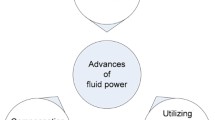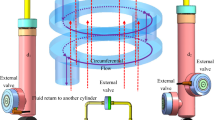Abstract
This article presents a novel rotary magnetorheological fluid device with inherently low off-state torque. The working principle of the device is similar to peristaltic pumps except the fluid remains inside the device and circulates continuously. Unlike other continuous rotation magnetorheological fluid devices, which operate in shear mode, the proposed device works in pressure driven flow mode. A proof of concept prototype with arbitrary dimensions is built and experimentally evaluated. Measured off-state torque is as low as 20 N.mm. Analytical model of the resistant torque and finite element simulations of the magnetic circuit are presented and validated with the experimental results. Using these models, an optimal device with similar off-state characteristics can be designed to fulfill specific requirements of size, weight, power and on-state torque. The proposed concept is promising especially for use in high precision haptic interfaces that require stability and transparency at the lower end of force spectrum.










Similar content being viewed by others
References
Shafer AS, Kermani MR (2011) Design and validation of a magneto-rheological clutch for practical control applications in human-friendly manipulation. In: Proceedings of the IEEE International Conference on Robotics and Automation, Shanghai, China, pp 4266–4271
Kuchenbecker KJ, Niemeyer G (2006) Induced master motion in force-reflecting teleoperation. J Dyn Syst Meas Control 128:800–810. https://doi.org/10.1115/1.2364011
An J, Kwon D-S (2006) Stability and performance of haptic interfaces with active/passive actuators-theory and experiments. Int J Rob Res 25:1121–1136. https://doi.org/10.1177/0278364906071034
Najmaei N, Kermani MR, Patel RV (2015) Suitability of small-scale magnetorheological fluid-based clutches in haptic interfaces for improved performance. IEEE/ASME Trans Mechatron 20:1863–1874. https://doi.org/10.1109/TMECH.2014.2357447
Olabi AG, Grunwald A (2007) Design and application of magneto-rheological fluid. Mater Des 28:2658–2664. https://doi.org/10.1016/j.matdes.2006.10.009
Kikuchi T, Ikeda K, Otsuki K et al (2009) Compact MR fluid clutch device for human-friendly actuator. J Phys 149:12059. https://doi.org/10.1088/1742-6596/149/1/012059
Guo H, Liao WH (2011) Optimization of a multifunctional actuator utilizing magnetorheological fluids. In: IEEE/ASME International Conference on Advanced Intelligent Mechatronics, Budapest, Hungary, pp 67–72
Rossa C, Jaegy A, Micaelli A, Lozada J (2014) Development of a multilayered wide-ranged torque magnetorheological brake. Smart Mater Struct 23:25028. https://doi.org/10.1088/0964-1726/23/2/025028
Senkal D, Gurocak H (2010) Serpentine flux path for high torque MRF brakes in haptics applications. Mechatronics 20:377–383. https://doi.org/10.1016/j.mechatronics.2010.02.006
Avraam M, Horodinca M, Romanescu I, Preumont A (2010) Computer controlled rotational MR-brake for wrist rehabilitation device. J Intell Mater Syst Struct 21:1543–1557. https://doi.org/10.1177/1045389X10362274
Nguyen QH, Choi SB (2012) Optimal design of a novel hybrid MR brake for motorcycles considering axial and radial magnetic flux. Smart Mater Struct 21:55003. https://doi.org/10.1088/0964-1726/21/5/055003
Nguyen QH, Nguyen ND, Choi S-B (2015) Design and evaluation of a novel MR brake with coils placed on side housings. Smart Mater Struct 9059:90590I. https://doi.org/10.1117/12.2044561
Demersseman R, Hafez M, Lemaire-Semail B, Clénet S (2008) Magnetorheological brake for haptic rendering. In: Ferre M (ed) Haptics perception, devices scenar. EuroHaptics 2008, vol 5024. Lect. Notes Comput. Sci. Springer, Heidelberg, pp 941–945
Liu B, Li WH, Kosasih PB, Zhang XZ (2006) Development of an MR-brake-based haptic device. Smart Mater Struct 15:1960–1966. https://doi.org/10.1088/0964-1726/15/6/052
Najmaei N, Asadian A, Kermani M, Patel R (2015) Design and performance evaluation of a prototype MRF-based haptic interface for medical applications. IEEE/ASME Trans Mechatron 21:110–121. https://doi.org/10.1109/TMECH.2015.2429140
Gonenc B, Gurocak H (2012) Haptic interface with hybrid actuator for virtual needle insertion and tissue cutting. In: Proceedings of the IEEE Haptics Symposium, 2012. Vancouver, Canada, pp 451–455
Okamura AM, Webster RJ, Nolin JT, et al (2003) The haptic scissors: cutting in virtual environments. In: Proceedings of the ICRA’03. IEEE International Conference on Robotics and Automation, Taipei, Taiwan, pp 828–833
Mahvash M, Voo LM, Kim D et al (2008) Modeling the forces of cutting with scissors. IEEE Trans Biomed Eng 55:848–856. https://doi.org/10.1109/TBME.2007.908069
van Gerwen DJ, Dankelman J, van den Dobbelsteen JJ (2012) Needle-tissue interaction forces—a survey of experimental data. Med Eng Phys 34:665–680. https://doi.org/10.1016/j.medengphy.2012.04.007
Polytek Development Corp. (2015) Poly 74- series liquid rubbers technical bulletin. http://www.polytek.com/. Accessed 20 Jan 2017
Jolly MR, Bender JW, Carlson JD (1999) Properties and applications of commercial magnetorheological fluids. J Intell Mater Syst Struct 10:5–13. https://doi.org/10.1177/1045389X9901000102
Grunwald A, Olabi AG (2008) Design of magneto-rheological (MR) valve. Sens Actuators A 148:211–223. https://doi.org/10.1016/j.sna.2008.07.028
Meeker D (2015) Finite element method magnetics (FEMM)—version 4.2 User’s Manual. http://www.femm.info/. Accessed 20 Jan 2017
LORD Corp. (2011) MRF-132DG Datasheet. http://www.lordmrstore.com/. Accessed 20 Jan 2017
Acknowledgement
This research is supported by The Scientific and Technological Research Council of Turkey (TUBITAK) under grant 115M019.
Author information
Authors and Affiliations
Corresponding author
Additional information
Technical Editor: Sadek C. Absi Alfaro.
Rights and permissions
About this article
Cite this article
Topçu, O., Taşcıoğlu, Y. & İlhan Konukseven, E. Modeling and experimental evaluation of a rotary peristaltic magnetorheological fluid device with low off-state torque for haptic interfaces. J Braz. Soc. Mech. Sci. Eng. 40, 9 (2018). https://doi.org/10.1007/s40430-017-0930-6
Received:
Accepted:
Published:
DOI: https://doi.org/10.1007/s40430-017-0930-6




